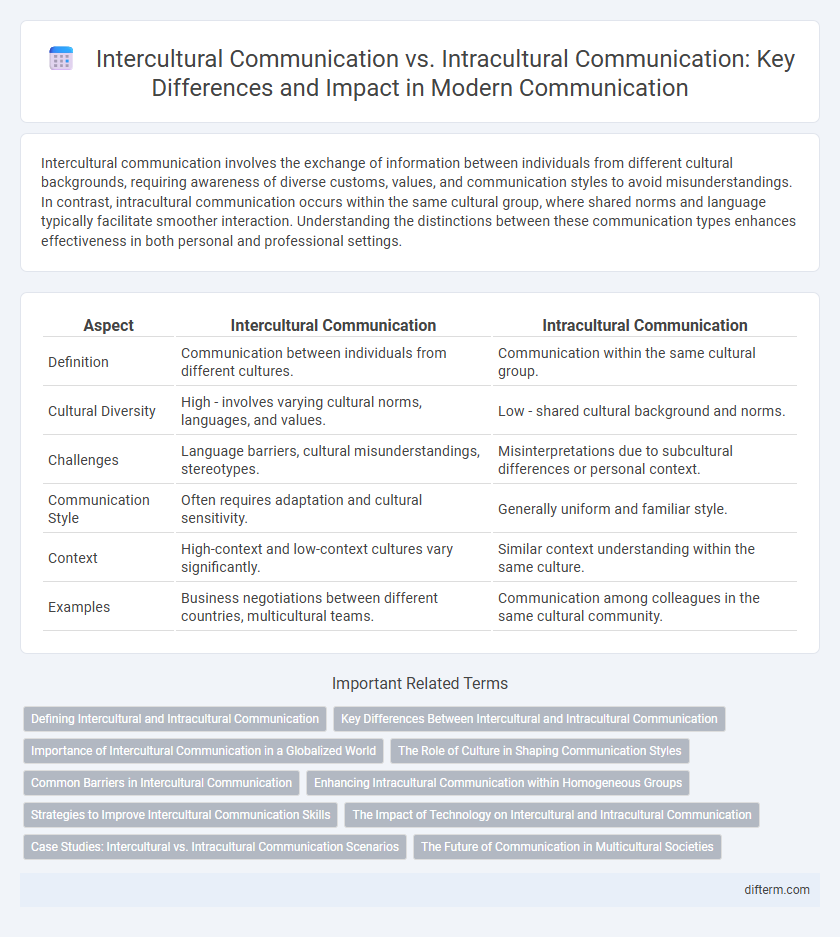Intercultural communication involves the exchange of information between individuals from different cultural backgrounds, requiring awareness of diverse customs, values, and communication styles to avoid misunderstandings. In contrast, intracultural communication occurs within the same cultural group, where shared norms and language typically facilitate smoother interaction. Understanding the distinctions between these communication types enhances effectiveness in both personal and professional settings.
Table of Comparison
| Aspect | Intercultural Communication | Intracultural Communication |
|---|---|---|
| Definition | Communication between individuals from different cultures. | Communication within the same cultural group. |
| Cultural Diversity | High - involves varying cultural norms, languages, and values. | Low - shared cultural background and norms. |
| Challenges | Language barriers, cultural misunderstandings, stereotypes. | Misinterpretations due to subcultural differences or personal context. |
| Communication Style | Often requires adaptation and cultural sensitivity. | Generally uniform and familiar style. |
| Context | High-context and low-context cultures vary significantly. | Similar context understanding within the same culture. |
| Examples | Business negotiations between different countries, multicultural teams. | Communication among colleagues in the same cultural community. |
Defining Intercultural and Intracultural Communication
Intercultural communication involves the exchange of information between individuals from different cultural backgrounds, emphasizing understanding and adapting to diverse cultural norms, languages, and values. Intracultural communication occurs within a single cultural group, where shared language, traditions, and social norms create a common framework for interaction. Distinguishing between these two types highlights the challenges of managing cultural differences versus reinforcing homogenous cultural identities in communication processes.
Key Differences Between Intercultural and Intracultural Communication
Intercultural communication involves the exchange of information between individuals from different cultural backgrounds, emphasizing the challenges of cultural norms, language barriers, and diverse communication styles. Intracultural communication occurs within the same cultural group, where shared values, language, and social norms facilitate smoother and more predictable interactions. The key differences lie in cultural context complexity, potential for misunderstandings, and the need for cultural sensitivity in intercultural settings compared to the relative familiarity in intracultural communication.
Importance of Intercultural Communication in a Globalized World
Intercultural communication is essential in a globalized world as it enables effective interaction among individuals from diverse cultural backgrounds, fostering mutual understanding and reducing conflicts. Unlike intracultural communication, which occurs within the same cultural group, intercultural communication bridges cultural gaps by navigating differences in language, values, and social norms. Mastery of intercultural communication skills enhances global business success, international diplomacy, and cultural exchange by promoting empathy and collaboration across cultural boundaries.
The Role of Culture in Shaping Communication Styles
Culture profoundly influences communication styles by shaping the norms, values, and expectations within a group. Intercultural communication involves navigating diverse cultural frameworks to achieve mutual understanding, while intracultural communication occurs among individuals sharing the same cultural background, resulting in more homogeneous communication patterns. Understanding these distinctions is essential for effective interaction, conflict resolution, and fostering inclusivity in global and multicultural environments.
Common Barriers in Intercultural Communication
Common barriers in intercultural communication include language differences, nonverbal misinterpretations, and ethnocentrism, which hinder effective message exchange between individuals from diverse cultural backgrounds. Unlike intracultural communication, where shared cultural norms facilitate understanding, intercultural exchanges often face challenges caused by contrasting values, communication styles, and stereotypes. Overcoming these barriers requires cultural awareness, empathy, and adaptive communication strategies to foster clarity and mutual respect.
Enhancing Intracultural Communication within Homogeneous Groups
Enhancing intracultural communication within homogeneous groups improves shared understanding by leveraging common cultural norms, values, and language patterns. This alignment reduces misinterpretations and streamlines collaboration through culturally reinforced communication channels. Fostering strong intracultural communication boosts group cohesion, trust, and overall effectiveness in achieving collective goals.
Strategies to Improve Intercultural Communication Skills
Effective strategies to improve intercultural communication skills include developing cultural awareness by learning about different cultural norms, values, and communication styles to minimize misunderstandings. Active listening and empathy enhance the ability to interpret messages accurately and respond appropriately across cultural boundaries. Practicing adaptability and open-mindedness enables smoother interactions by accommodating diverse perspectives and reducing ethnocentric biases in both professional and personal settings.
The Impact of Technology on Intercultural and Intracultural Communication
Technology enhances both intercultural and intracultural communication by enabling instant, diverse, and widespread interactions that transcend geographical boundaries. Digital platforms facilitate real-time translation, cultural exchange, and collaborative problem-solving, improving understanding and reducing misunderstandings in intercultural contexts. Within intracultural communication, technology strengthens social cohesion and information sharing by connecting individuals who share common cultural backgrounds through social media, virtual communities, and communication apps.
Case Studies: Intercultural vs. Intracultural Communication Scenarios
Case studies on intercultural communication reveal challenges in language barriers, differing cultural norms, and misinterpretations between individuals from distinct cultural backgrounds, often requiring enhanced cultural sensitivity training. In contrast, intracultural communication scenarios typically demonstrate smoother interactions due to shared cultural references, language, and social norms, although misunderstandings can still arise from subcultural differences. Analyzing these case studies highlights the critical role of context, cultural awareness, and adaptive communication strategies in improving both intercultural and intracultural exchanges.
The Future of Communication in Multicultural Societies
Intercultural communication, which involves exchanging information between people from different cultural backgrounds, is critical as multicultural societies continue to grow globally. Intracultural communication occurs within the same cultural group and fosters deeper understanding and cohesion among members, but the future emphasizes blending both to enhance mutual respect and collaboration. Advances in technology and increasing global mobility will drive the evolution of communication strategies that accommodate cultural diversity and promote inclusivity in social, professional, and educational contexts.
intercultural communication vs intracultural communication Infographic

 difterm.com
difterm.com